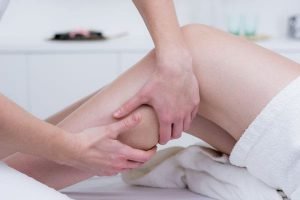
Calf Strains
Calf Strains

- Grade 1 calf strain – A minor tear with up to 10% of the muscle fibres involved
- Grade 2 injury – A more severe tear involving up to 90% of the muscle fibres
- Grade 3 injury – Usually a very severe strain or complete rupture of the muscle
Treatment and Rehabilitation:
A structured rehabilitation program is important for optimum recovery from a calf strain or tear.
Initially, the Rest, Ice, Compression, Elevation (R.I.C.E) principal should be followed. Therapeutic Ultrasound, Dry Needling, Sports massage and Taping are all methods used to facilitate soft tissue healing. Sports massage, however should not be performed until the acute phase has passed (3 days +). Approximate timescales for rest are;
- Grade 1 strain – 3 weeks
- Grade 2 strain – 4 -6 weeks
- Grade 3 tears may require surgery followed by a 12 week rehabilitation program
As with any injury, progressive and comprehensive exercise based rehabilitation is key to avoiding recurrence or secondary injuries. Secondary injuries often occur through compensatory mechanisms which may have become habit during the injured period. The rehabilitation period is also an ideal opportunity to target those areas that get ignored in weekly training routines. Core stability and gluteal muscles are a great place to focus on when activity is restricted. Research has found that the stronger these muscles can become, the more likely a successful outcome is to be reached in terms of injury recovery, injury prevention and most importantly performance.
Stages that need to be covered to effectively rehabilitate these injuries and prevent recurrence are:
Regain Full Range of Motion. It is important to lengthen and orientate the healing scar tissue via massage, muscle stretches and neurodynamic mobilisations.
Restore Concentric Muscle Strength. Calf strength and power should be gradually progressed from non-weight bearing to partial and then full weight bearing and resistance loaded exercises. The patient may also require strengthening for other leg, gluteal and lower core muscles depending on the assessment findings.
Restore Eccentric Muscle Strength. Most calf muscle tears occur during the controlled lengthening phase. The physiotherapist will guide the patient on an eccentric calf strengthening program.
Restore High Speed, Power, Proprioception and Agility. Most calf injuries occur during high speed activities, which place enormous forces on the body, contractile and non-contractile. In order to prevent a recurrence as the patient returns to sport, the physiotherapist will guide them with exercises to address these important components of rehabilitation to both prevent a recurrence and improve their sporting performance.
Return to Sport. Depending on the demands of the chosen sport, the patient will require sport-specific exercises and a progressed training regime to enable a safe and injury-free return to their chosen sport.
Early intervention is the most important part in helping patients achieve the best and fastest results possible. Physiotherapy is an essential ingredient in treating Calf Injuries. Visit our Duncraig Physio page and book an appointment today.